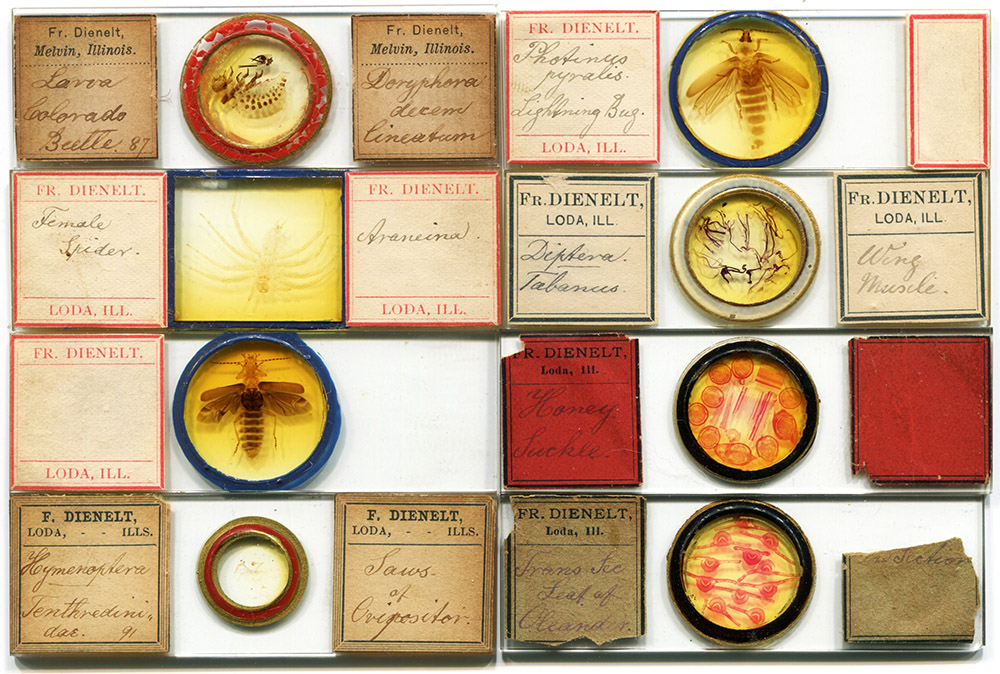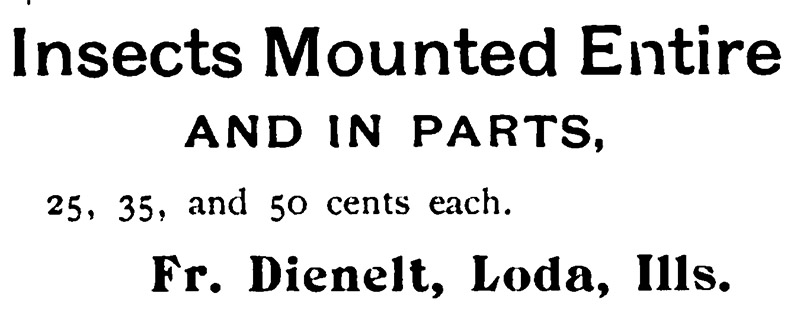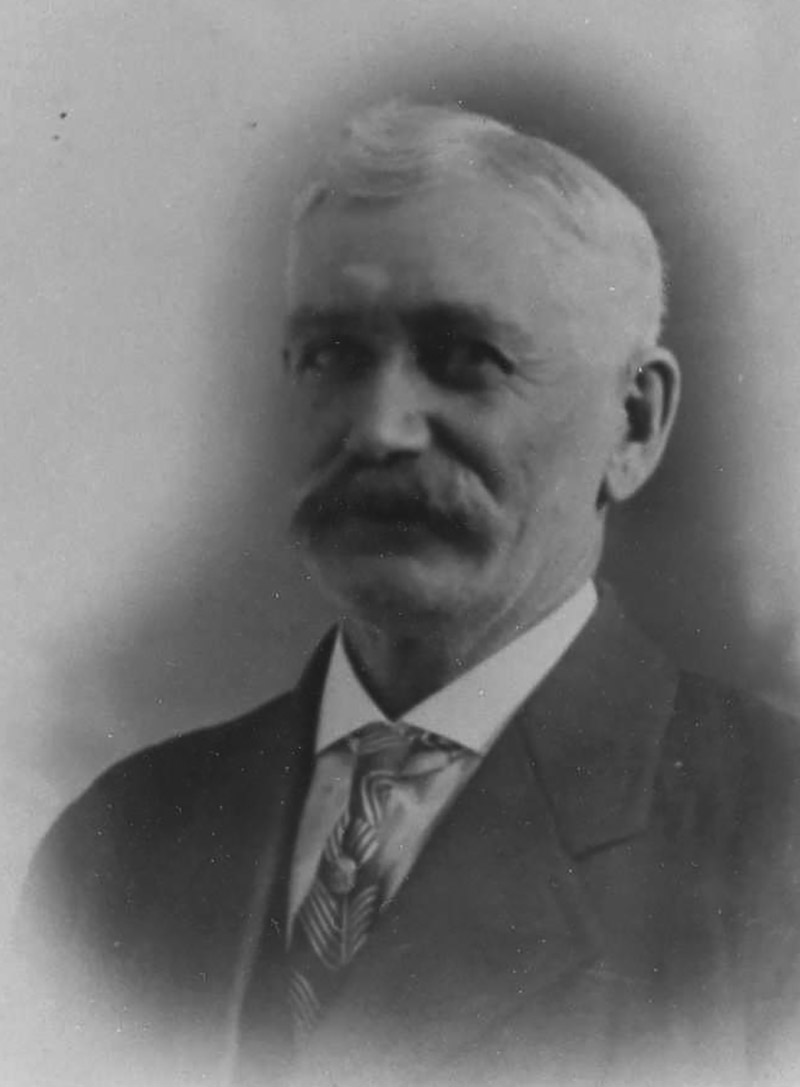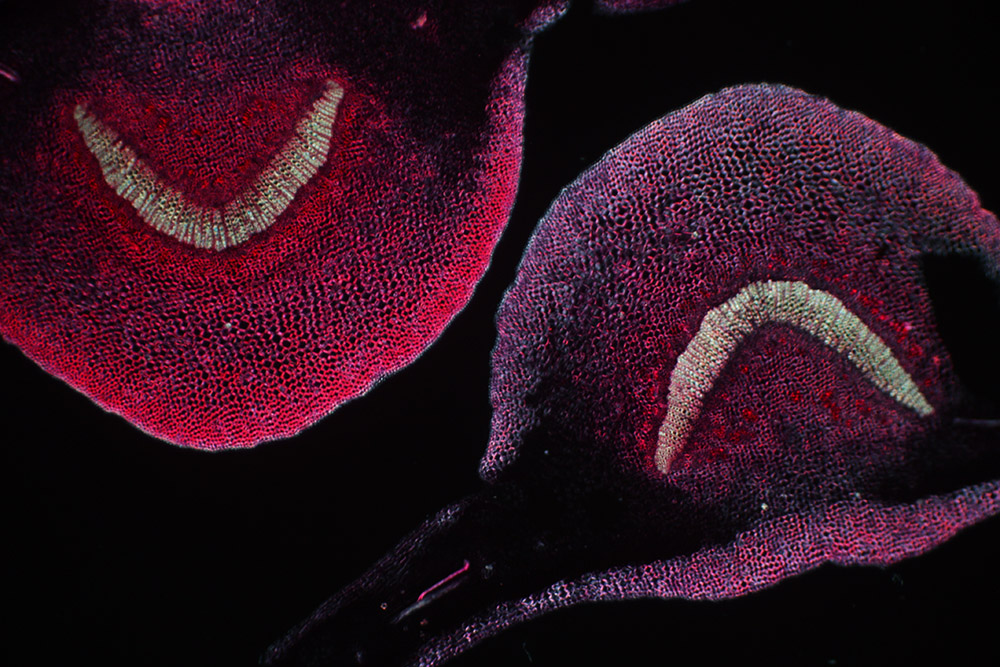Frederick Dienelt, 1828 - 1905
by Brian Stevenson
last updated October, 2020
During the mid- to late-1800s, people of every class and educational background were drawn to amateur scientific studies. At that time, little was known about details of the natural word, so almost any investigation was bound to break new ground. An inquisitive mind was all that was necessary. Frederick Dienelt had little formal education, and worked for most of his life as a homestead farmer on the plains of Illinois, USA, yet became a well-regarded microscopist by diligently exploring the anatomy of insects and other organisms.
He wrote, “Robinson Crusoe was the first book I called my own. Its contents made me run away from home at the age of 15, to become a sailor. Being of a rather independent turn of mind, and wishing to be my own master, in 1857, after 14 years of ocean life, came to Illinois to try to be a farmer, settling on a part of the grand prairie eleven miles from the nearest railroad station. The prairie was at that time much as the Indians had left it. Neighbors were few and far between. This drove me into a close communion with Nature, and gave me a love for investigation. Without books, and with only a common school education, progress was slow. I had saved a ship's spy-glass from a wreck, and, aided by a star map of one foot in diameter, learned the constellations and spent many happy hours in star gazing … After I got out of debt and had my farm pretty comfortable for man and beast, I could at last indulge myself. I purchased books and instruments, and in my humble way learned to use them. I procured them all with the proceeds of horny handed labor, but have always held that every dollar spent was a good investment. I have enjoyed my leisure and my old eyes have seen much that used to be dark in former days”.

Figure 1.
Microscope slides by Frederick Dienelt. Early slides bear the address of Melvin, Illinois, while later slides give his address as Loda, Illinois. Dienelt did not move his home - he lived on a farm several miles from either settlement, and the address change reflects the post office that he used. The address change occurred between 1888 and 1891. The top, left slide is dated 1887, and the slide on the bottom left is dated 1891.

Figure 2.
An 1893 advertisement for Dienelt’s microscope slides, from “The Observer”,.

Figure 3.
Slides of insect parts by Dienelt: on the left, antennae of various beetle species; on the right, pieces of a dissected cricket (Gryllus campestris).

Figure 4.
Frederick Dienelt. Adapted from https://www.ancestry.com/family-tree/person/tree/29941324/person/12536787900
Dienelt was born on May 8, 1828, in Braunschweig, Saxony (Germany). His given name was presumably Friedrich, later anglicized to Frederick. In writing, he frequently referred to himself as “Fr.”, perhaps a compromise between the two spellings.
As noted above, he left home at the age of 15 to become a sailor. Local historian Ernest Gardner, who evidently knew Dienelt, wrote, “In 1843 he went to sea, sailing around the world before he was seventeen years old, and there are few places in this hemisphere that have not been visited by him”. Dienelt emigrated to the USA in 1857, then, according to Gardner, “he came to Ford county in 1858, being the second settler in this township”.
He married Mary Kaminsky, a fellow German - it is not clear whether they married after he settled in Illinois or before that time. They had three children, the first born in 1861. Dienelt gradually expanded his farmstead, adding 40 acres in 1870, and reaching an expanse of 190 acres by 1884. Mary died in 1872. The following year, Dienelt married Samantha (Mattie) Wells. They did not have any further children.
Frederick probably began his microscopical work during the early 1880s. He wrote a letter to The American Monthly Microscopical Journal in early 1884 on his method of reusing slides, implying that his earliest attempts at slide-making had not been long in the past, “finding myself out of slides lately, and having a good chance to procure some good material, I condemned a dozen of my first attempts at mounting”. In June, 1884, and again in March, 1885, he wrote to the same magazine for advice on ringing slides.
He was, however, reasonably adept at both the use of the microscope and preparing slides by early 1885. The same letter to The American Monthly Microscopical Journal in which he requested advice on ringing included these comments: “Enclosed please find $1 to renew subscription; wish it had to be $2 for a double dose. Last summer I bought an immersion 1/10 of Spencer, and asked you for some advice in regard to handling it, and was told to 'go at it.' I have done so, and now go up to No. 19 very well, but am not willing to swear to a good resolution of A. pellucida yet. I for one need your long promised article on illumination very much, and pray devoutly that you may soon have leisure for it. I have Prof. E. Smith's celebrated ‘How to see with the Microscope, but have derived more benefit from your single sentence 'go at it,' than from all his highly mixed instructions, down to pulling out table drawer, and putting of napkins on the edge of it”, and “I had great trouble at first from cover breakage. Mr. Ward, in his very interesting paper on mounting, uses the expression ‘often breaking cover after cover.’ Let me tell you my plan. I think it is handier than your bullet pressure. It is some 25 years ago, when I sent my last bullet adrift, and missed at that. About that time deer took H. Greeley's advice and disappeared from this prairie. I suppose bullets can be found in city gun stores, but the American clothes-pin, my favorite, blossoms in every country store. I believe it is more readily to be had. After adopting the following plan, I have not lost more than two per cent of covers. I cut squares of glass a little smaller than the covers, to put on the cover before applying the clothes-pin. the pressure as evenly as a bullet can; besides the pin forms a convenient handle, quite an advantage in handling slow-drying mounts. I also make the handles do as temporary labels by writing the name of object on them. I enclose the best envelope I have, and shall be much obliged for a little material for mounting: Please command me if I can ever be of service to you, and accept my best wishes for yourself and the new volume. I for one never yet made the acquaintance of the man that pleased everybody and amounted to much himself”.
Dienelt joined the American Society of Microscopists during their August, 1886, meeting in Chautauqua, New York.
He rapidly developed his mounting skills. In 1887, Dienelt published a paper on “The preparation of insect spiracles” in The Microscope. In 1888, that magazine’s editors acknowledged receipt “from Fr. Dienelt, Melvin, Ill., fine mount of spiracles of Copris” and “mount of spiracles of coleoptera larva”. Another acknowledgement, in 1890, thanked “Mr. Fr. Dienelt for mounts of insects and plant sections. Mr. Dienelt merits much for his microscopical pursuits. A sailor for fourteen years, a farmer for thirty, now at the age of sixty-two he is a successful microscopist. He uses good objectives, having Spencer's homogeneous immersion one-tenth. Mr. Dienelt and his work should be incentives to younger men to do more than he, and if possible, better”.
Dienelt changed post offices between the 1888 acknowledgement and this 1891 advertisement: “For sale - B. & L. bull's eye 3 in. condenser, in perfect order. $6., purchaser to pay expressage. Fr. Dienelt, Loda, Ill.” His slides can presumably be dated by this address change, with Melvin prior to 1888-1891, and Loda afterwards.
In 1892, The Microscope thanked “Mr. F. Dienelt, Loda, Ill., for three slides of the anatomy of the honey bee. These are the result of much careful dissection, work in which Mr. Dienelt is expert”.
Two articles were published in The Observer in 1892, “Diatoms in winter, a singular find”, and “Glycerine cell mounting of insect internal parts”.
Dienelt began selling his slides in 1893 (Figure 2). His frequent gifts of slides to magazine editors paid off with additional free advertising. The Observer wrote in 1893, “(Acknowledgement) to Fr. Dienelt of Loda, Ill, for insect mounts, slides showing whole insects, and slides containing the whole anatomy of an insect under one cover. This last feature is an excellent one, both facilitating study, and economizing cabinet room. Mr. Dienelt is a thorough student of insect anatomy, as our readers know from his frequent contributions to these columns. And we are glad to be able to state that insect mounts may be purchased from Mr. Dienelt. Mr. Dienelt’s entomological notes will render his mounts additionally desirable”, and “We have received several fine preparations of well displayed insect anatomy from Fr. Dienelt of Loda, Ill. In the sense that ‘a poet is born, not made’, Mr. Dienelt may be said to be a born microscopist. Intending purchasers of insect mounts will do well to communicate with Mr. Dienelt”.
During the following years, Dienelt published several additional articles with hints on slide-making and insect physiology. Anecdotes of his life as a homesteader were published in 1893.
His slides benefitted other scientifically-inclined microscopists, such as Alfred Stokes, who wrote in 1894, “Some months ago my correspondent, Mr. Fr. Dienelt, of Loda, Illinois, sent me a microscope slide of the tracheae of the not uncommon aquatic bug, Zaitha fluminea”, and “(I) call attention to certain tracheal appendages which were discovered by Dujardin as long ago as 1849, and by him referred to in a brief note published on page 674 of Comptes Aendus for that year. Since then they seem to have been almost forgotten. These are internal, chitinous, hair-like bodies arising from the fold of the taenidia, and projecting into the lumen of the tubes. Dujardin gives a list of the insects in whose tracheae he has seen these hairs, and remarks upon the evidence which they afford as to the external origin of the tracheal intima. A few scattered references to the observation may be found in the European literature of the subject, with absolutely none in this country, with the exception of one contribution by Dr. Henry Shimer, of Mount Carroll, Ill., in an elementary microscopical magazine, with one or two made by me in the same journal, my hope being thereby to interest amateur microscopists in the matter, and one or two additional notes by Mr. Fr. Dienelt in a similar magazine (The Observer, Portland, Conn.), intended to accomplish the same purpose. This occurred within the last two years, and with these unimportant exceptions, internal tracheal hairs seem never to have been noticed by any American microscopist, although insects possessing them are not uncommon. My own first acquaintance with them was brought about through the courtesy of my correspondent, Mr. Fr. Dienelt, of Loda, Illinois, who sent me a slide of the tracheae from the common Colorado potato beetle (Doryphora decemlineata), calling my attention to certain appearances within them which he was at a loss to interpret. These proved to be produced by tracheal hairs similar to those discovered by Dujardin, and since examining that preparation I have seen the appendages in the tracheae from the ovipositor of the common house fly; whilst Mr. Dienelt has observed them in several other insects ; indeed, it was he who called my attention to their abundance and to their great size in the tracheae of Zaitha fluminea”.
Dienelt was listed in the 1900 US census as being a “naturalist”. Gardner’s History of Ford Count, Illinois, stated that “His library was considered the largest and most valuable of any person's - excepting professional men - in the county, and much of his time was passed in reading scientific works and studying astronomy”. E.W. Roberts wrote in 1912, “Mr. Dienelt introduced the writer to beauties of insect microscopy. This great hearted farmer, microscopist, and astronomer was, for more than 60 years, an arduous worker in the advancement of his favorite studies. During this time he made upward of 20,000 microscopic slides illustrating insect structure”.
Frederick Dienelt died in March, 1905, aged 77.

Figure 5.
Transverse-sections of an Oleander leaf. Cut, stained, and mounted by Frederick Dienelt, ca. 1895. Photographed using a 3.5x objective lens and crossed polarizing filters.

Figure 6.
“Saw of ovipositor” of a Tenthredinidae sawfly, prepared by Frederick Dienelt in 1891. Both photographed through a 3.5x objective lens. Left, with normal transmitted light. Right, with crossed polarizing filters.
Resources
Dienelt, Frederick (1884) Cleaning slides and covers, The American Monthly Microscopical Journal, Vol. 5, page 59
Dienelt, Frederick (1885) Various subjects, The American Monthly Microscopical Journal, Vol. 6, pages 59-60
Dienelt, Frederick (1886) Durability of white zinc cement, The Microscope, Vol. 7, page 102
Dienelt, Frederick (1887) The preparation of insect spiracles, The American Monthly Microscopical Journal, Vol. 7, page 78
Dienelt, Frederick (1892) Diatoms in winter, a singular find, The Observer, Vol. 3, page 41
Dienelt, Frederick (1892) Glycerine cell mounting of insect internal parts, The Observer, Vol. 3, pages 203-205
Dienelt, Frederick (1893) Gold size, The Observer, Vol. 4, pages 132-133
Dienelt, Frederick (1893) Some Reminiscences, The Observer, Vol. 4, pages 190-192
Dienelt, Frederick (1893) Dissecting insects, The Observer, Vol. 4, pages 364-368
Dienelt, Frederick (1896) Hints for beginners, The Observer, Vol. 7, pages 346-347
Dienelt, Frederick (1896) The honey bee and her wax, The Observer, Vol. 7, pages 401-405
Dienelt, Frederick (1896) Discoloration of balsam in benzole, The Observer, Vol. 7, page 540
Dienelt, Frederick (1896) Insect notes, The Observer, Vol. 7, pages 592-593
Dienelt, Frederick (1897) The sound producing apparatus of the bee fly, Eristalis tenax, The Observer, Vol. 8, pages 174-175
Gardner, Ernest A. (1908) History of Ford County, Illinois, S.J. Clarke, Chicago, pages 168-169
Land purchase record, 40 acres by Frederick Dienelt (1870) accessed through ancestry.com
Map of Wall Township (1884) accessed through ancestry.com
The Microscope (1888) Acknowledgements, Vol. 8, page 62
The Microscope (1890) Acknowledgement, Vol. 10, page 91
The Microscope (1891) Sale advertisement from F. Dienelt, Vol. 11, page 6
The Microscope (1892) Acknowledgement, Vol. 12, page 25
The Observer (1893) Acknowledgements, Vol. 4, pages 2 and 34
The Observer (1893) Advertisements for sale of slides by Frederick Dienelt, Vol. 4, numerous issues
Proceedings of the American Society of Microscopists, Ninth Meeting (1886) “Friday, Aug 13 AM Session, The following were elected members:, Fred. Dienelt, Melvin, Ill”, pages 215-216
Roberts, E.W. (1912) The modern theory of the cell as a complex of organized units, Proceedings of the American Society of Microscopists, Vol. 31, pages 85-114
Stokes, Alfred C. (1894) The structure of insect tracheae, with special reference to those of Zaitha fluminea, International Journal of Microscopy & Natural Science, Vol. 13, pages 361-368
US census and other records, accessed through ancestry.com





